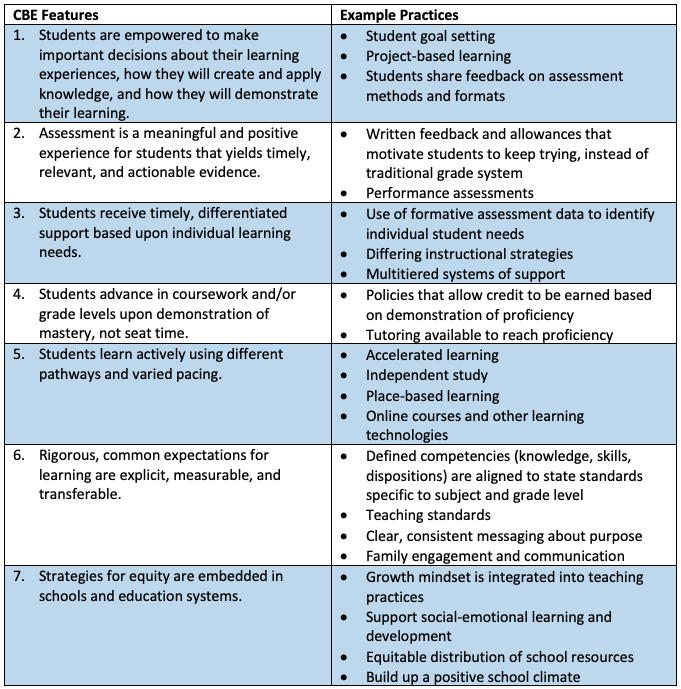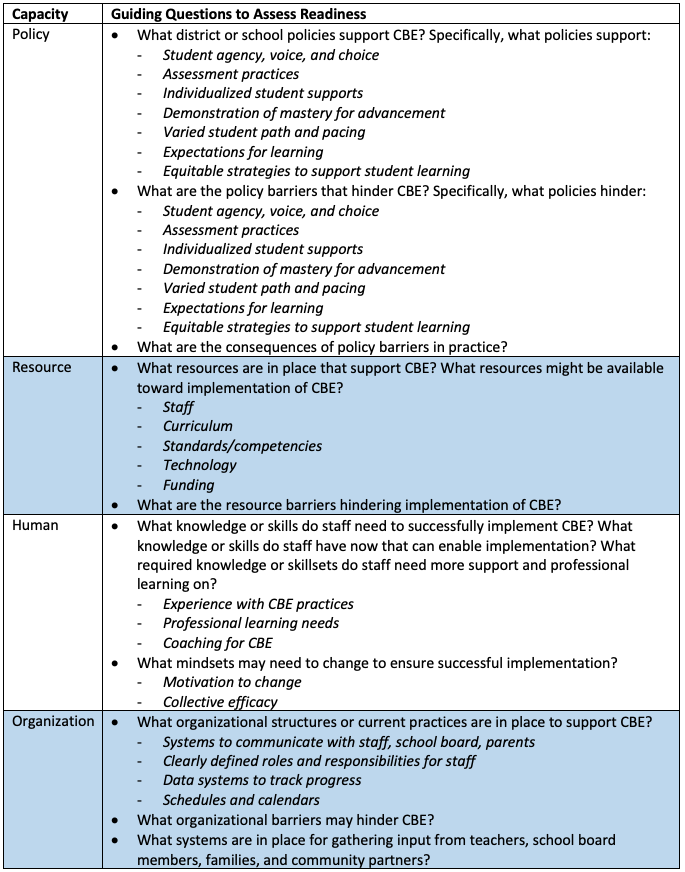By Katie Allen
Student-centered learning has shown great potential for increasing student interest and engagement in school. Actively involving student voice and choice in what, how, and when they learn—in effect creating personalized learning opportunities—can lead to increased academic success. As more schools begin using personalized learning approaches, some are looking at competency-based education (CBE) as a framework aligned to personalization to ensure that students truly learn and master content standards.
If your school or district is considering a shift to CBE, a first step is to familiarize yourself with CBE and then assess your readiness to make this innovative change. But how do you assess your school’s readiness for competency-based education? Drawing on a readiness assessment tool recently designed by the Region 12 Comprehensive Center (operated by McREL), I have some tips and practical recommendations to help your school plan for implementing CBE. But first, let’s define competency-based education.
What is competency-based education?
Competency-based education focuses on giving students a voice and choice in their learning, providing tailored learning and flexible pacing to meet their individual needs, and offering students assessment options that allow them to demonstrate their mastery of course content and standards. At the foundation of CBE is the belief that all students can learn when provided instruction that fits their learning needs. This includes aspects of personalized learning such as making learning relevant to a student’s cultural or community background and the student’s personal interests, as well as differentiating time needed to learn for each student. In short, CBE is personalized, student-centered education design with a focus on student application of their learning and demonstration of mastery.
CBE practices have rigorous and measurable expectations for learning (such as meeting or exceeding state learning standards) as well as meaningful assessments that provide timely and actionable feedback for teaching and learning. According to the Aurora Institute, CBE education systems promote active student learning and have embedded strategies for equity.
Several states, for example Utah and South Carolina, have drawn on the work of the Aurora Institute to articulate what a CBE system can look like. The table below gives an overview of seven defining features of CBE and examples of each feature in practice. It’s important to keep in mind that the actual practices of CBE will differ from school to school based on each system’s assets, including educator capacity, organizational structures and processes, available resources, and policy guidance (more on that a little later).
CBE Features and Example Practices
Benefits of Competency-Based Education
Due to variations in how schools and districts implement CBE, much of the research that supports these practices is based in other related areas such as learning sciences, social-emotional growth, and personalized learning. However, a recent meta-analysis of CBE research found connections between CBE and improved student outcomes such as increased academic success, motivation, and engagement.
For example, a 2017 REL Central study discovered that CBE accelerated learning in math and reading for students who were behind a grade level. Similarly, a 2017 Rand study on personalized learning using tailored pace and instruction—components of CBE—found positive effects on student math scores and found that it accelerated learning to help students catch up academically to their peers. Other research found that students who experienced practices associated with CBE, particularly setting learning goals in math and English language arts, had improved intrinsic motivation to learn.
Because CBE is a conceptual framework rather than a prescribed program or curriculum, each education system that adopts CBE as a guiding philosophy must determine how to innovate and implement it based on its students’ needs and taking into consideration existing policies and practices.
Assessing Readiness for Competency-Based Education
Transitioning to a CBE approach is not an overnight change schools and teachers can undertake. CBE should be a thoughtfully planned and steady transition. Planning for any innovation, including CBE, is a process that requires identifying student needs, articulating goals and objectives, assessing concerns of staff, creating action and monitoring plans, and identifying key roles and responsibilities. Conducting an organizational readiness assessment is an essential part of this planning process.
Assessing readiness is a process to help an organization gauge how prepared it is to undertake change. Just as students are assessed for their readiness to enter school or move onto college and career, schools and districts also should reflect on their ability to innovate and change. In theory, the greater an organization’s readiness, the more likely it is to reach its goals.
Completing a readiness assessment provides multiple benefits that increase an innovation’s likelihood for success. A quality readiness assessment process can identify gaps in resources, policies, or practices required for implementing best practices within a CBE framework. It also can identify potential points of entry, which can be used as starting places for CBE implementation. The readiness assessment also helps educators identify and prepare for challenges that could arise when they’re implementing new procedures or processes. Talking with stakeholders—teachers, students, parents, for example—during the readiness assessment can help school leaders better understand areas of strength and areas of need, and how to effectively introduce new practices and adjust current practices.
Different systems conceptualize organizational readiness in different ways, but at its heart there are four distinct areas of capacity that education systems must build to undergo any successful change. These four capacities are:
- Human capacity, including the knowledge, skills, and motivation of staff to adapt to change.
- Organizational capacity, such as structures for communication and establishing clear roles and responsibilities.
- Resource capacity, which may include funding or other tangible resources required for implementation.
- Policy capacity, the guidelines and regulations that support (or hinder) enactment of the identified innovation.
Tools for assessing readiness may look like a checklist, rubric, or template. The readiness assessment tool shown below, designed by my colleagues at the Region 12 Comprehensive Center, is a template with a set of guiding questions and prompts that should be answered through informed discussions with stakeholders. These same readiness questions should be revisited with your stakeholders at regular intervals to review progress of capacity building and to consider any changes in context that may impact your CBE implementation.
Every school has unique local contexts, and this readiness assessment tool should be tailored to your school’s needs. Use it to guide conversations with your stakeholders about best practices that can support CBE implementation and to identify and discuss potential barriers that will need to be mitigated. These discussions also may raise other questions that you can then address during the CBE planning process.
Readiness Assessment Guiding Questions
What Next?
After completing an organizational readiness assessment, school and district leaders should think about how the results inform their next steps as an organization. Because CBE is a framework with multiple entry points, schools might first consider their area(s) of strongest capacity as an entry point.
For example, if your school has a strong emphasis on student goal setting, you might consider how to further build on this practice to emphasize student voice and choice in demonstrating mastery. This could take the form of incorporating discussion with students on how they will show that they have met their goals, giving students options such as traditional quizzes or class presentations, as well as modifying worksheets to document the process that the student has selected.
Next, identify action steps needed and develop a plan to build capacity around those CBE practices that you intend to implement.
Finally, because CBE is a framework that employs a wide variety of practices and often requires adaptive, iterative changes along the way, embed the readiness assessment as part of a plan-do-study-act process to continually build your school’s capacities for success.



